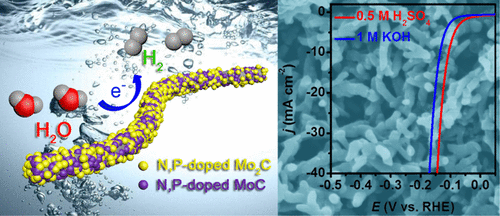当前位置:
X-MOL 学术
›
ACS Appl. Mater. Interfaces
›
论文详情
Our official English website, www.x-mol.net, welcomes your feedback! (Note: you will need to create a separate account there.)
N,P-Doped Molybdenum Carbide Nanofibers for Efficient Hydrogen Production
ACS Applied Materials & Interfaces ( IF 9.5 ) Pub Date : 2018-04-11 00:00:00 , DOI: 10.1021/acsami.8b00363 Lvlv Ji 1 , Jianying Wang 1 , Xue Teng 1 , Huan Dong 1 , Xiaoming He 1 , Zuofeng Chen 1
ACS Applied Materials & Interfaces ( IF 9.5 ) Pub Date : 2018-04-11 00:00:00 , DOI: 10.1021/acsami.8b00363 Lvlv Ji 1 , Jianying Wang 1 , Xue Teng 1 , Huan Dong 1 , Xiaoming He 1 , Zuofeng Chen 1
Affiliation

|
Molybdenum (Mo) carbide-based electrocatalysts are considered promising candidates to replace Pt-based materials toward the hydrogen evolution reaction (HER). Among different crystal phases of Mo carbides, although Mo2C exhibits the highest catalytic performance, the activity is still restricted by the strong Mo–H bonding. To weaken the strong Mo–H bonding, creating abundant Mo2C/MoC interfaces and/or doping a proper amount of electron-rich (such as N and P) dopants into the Mo2C crystal lattice are effective because of the electron transfer from Mo to surrounding C in carbides and/or N/P dopants. In addition, Mo carbides with well-defined nanostructures, such as one-dimensional nanostructure, are desirable to achieve abundant catalytic active sites. Herein, well-defined N,P-codoped Mo2C/MoC nanofibers (N,P-MoxC NF) were prepared by pyrolysis of phosphomolybdic ([PMo12O40]3–, PMo12) acid-doped polyaniline nanofibers at 900 °C under an Ar atmosphere, in which the hybrid polymeric precursor was synthesized via a facile interfacial polymerization method. The experimental results indicate that the judicious choice of pyrolysis temperature is essential for creating abundant Mo2C/MoC interfaces and regulating the N,P-doping level in both Mo carbides and carbon matrixes, which leads to optimized electronic properties for accelerating HER kinetics. As a result, N,P-MoxC NF exhibits excellent HER catalytic activity in both acidic and alkaline media. It requires an overpotential of only 107 and 135 mV to reach a current density of 10 mA cm–2 in 0.5 M H2SO4 and 1 M KOH, respectively, which is comparable and even superior to the best of Mo carbide-based electrocatalysts and other noble metal-free electrocatalysts.
中文翻译:

N,P掺杂的碳化钼纳米纤维可有效制氢
碳化钼(Mo)基电催化剂被认为是有前途的候选材料,可替代基于Pt的材料进行放氢反应(HER)。在Mo碳化物的不同晶相之间,尽管Mo 2 C表现出最高的催化性能,但其活性仍然受到强Mo-H键的限制。削弱强的Mo-H键,形成丰富的Mo 2 C /交通部接口和/或掺杂适量富电子(如N和P)掺杂剂进入沫2C的晶格是有效的,因为电子从Mo转移到碳化物和/或N / P掺杂物中的周围C中。另外,具有良好定义的纳米结构(例如一维纳米结构)的碳化钼对于获得丰富的催化活性位点是理想的。在此,通过磷钼酸盐([PMo 12 O 40 ] 3–,PMo 12的热解制备了定义明确的N,P掺杂的Mo 2 C / MoC纳米纤维(N,P-Mo x C NF)。)在Ar气氛下于900°C掺杂酸的聚苯胺纳米纤维,其中杂化聚合物前体是通过一种简便的界面聚合方法合成的。实验结果表明,热解温度的明智选择对于在Mo碳化物和碳基体中创建丰富的Mo 2 C / MoC界面并调节N,P掺杂水平至关重要,这可优化电子性能以加速HER动力学。结果,N,P-Mo x C NF在酸性和碱性介质中均表现出优异的HER催化活性。它仅需107和135 mV的过电势即可在0.5 MH 2 SO 4中达到10 mA cm –2的电流密度 和1 M KOH,分别相当于甚至优于基于Mo碳化物的电催化剂和其他无贵金属的电催化剂。
更新日期:2018-04-11
中文翻译:

N,P掺杂的碳化钼纳米纤维可有效制氢
碳化钼(Mo)基电催化剂被认为是有前途的候选材料,可替代基于Pt的材料进行放氢反应(HER)。在Mo碳化物的不同晶相之间,尽管Mo 2 C表现出最高的催化性能,但其活性仍然受到强Mo-H键的限制。削弱强的Mo-H键,形成丰富的Mo 2 C /交通部接口和/或掺杂适量富电子(如N和P)掺杂剂进入沫2C的晶格是有效的,因为电子从Mo转移到碳化物和/或N / P掺杂物中的周围C中。另外,具有良好定义的纳米结构(例如一维纳米结构)的碳化钼对于获得丰富的催化活性位点是理想的。在此,通过磷钼酸盐([PMo 12 O 40 ] 3–,PMo 12的热解制备了定义明确的N,P掺杂的Mo 2 C / MoC纳米纤维(N,P-Mo x C NF)。)在Ar气氛下于900°C掺杂酸的聚苯胺纳米纤维,其中杂化聚合物前体是通过一种简便的界面聚合方法合成的。实验结果表明,热解温度的明智选择对于在Mo碳化物和碳基体中创建丰富的Mo 2 C / MoC界面并调节N,P掺杂水平至关重要,这可优化电子性能以加速HER动力学。结果,N,P-Mo x C NF在酸性和碱性介质中均表现出优异的HER催化活性。它仅需107和135 mV的过电势即可在0.5 MH 2 SO 4中达到10 mA cm –2的电流密度 和1 M KOH,分别相当于甚至优于基于Mo碳化物的电催化剂和其他无贵金属的电催化剂。

























 京公网安备 11010802027423号
京公网安备 11010802027423号